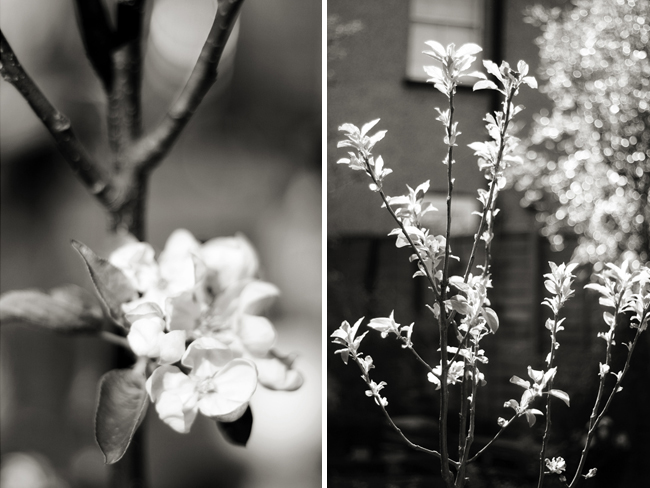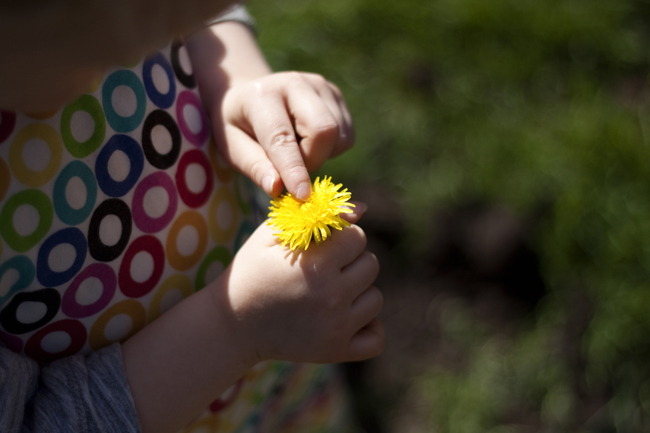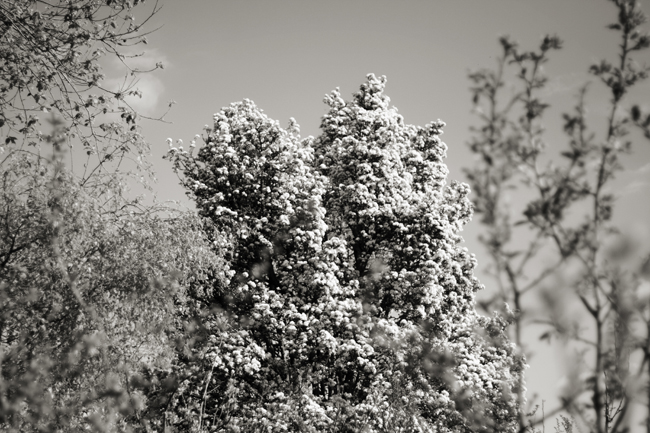My favourite thing about photographing other people's kids is spending a couple of hours revelling in the very specific eccentricities of a time in childhood that is totally different from the one we're swimming in at home. This week I photographed twins who had just turned one, when I photographed Harry in the woods he was a few weeks from his second birthday. Just Turned One and Almost Two are entirely different, equally charming planets from Three and Six Months. Almost Two is all about the trains, over and over and over the trains. Also about running away and chasing and piggy backs and hiding behind your parents legs. But mostly about the trains.
Monday, May 26, 2014
Thursday, May 08, 2014
The melancholy and promise of April in the garden.
Things are looking up in the garden. For a while there it was all brown and grey and really quite grim - not just in our garden, everywhere - and I was beginning to wonder (as I do every year) quite why we are living in the god awful country. Although I do try to remember that we used to have it worse. At least here while it was brown and grey and wet and grim I was not also continuously freezing my tits off. We've been back to Scotland a couple of times over the winter and I spent almost all of the first trip with a boob in each hand, in a desperate effort to keep my both my hands and my boobs from freezing and dying right there and then. The second time I took three jumpers with me and I wore them all.
It was a ridiculously mild winter here. There was no frost, none, which apparently means that this will be The Year of the Slug. The little fuckers are already decimating our lettuces and our courgettes. The surface reason for us not having done anything about them is that we're 'organic gardeners (man). We don't believe in like, chemicals and shit.' But the truth (as it so often is) is that we are crippled by indecision. There are too many products and techniques and opinions out there. So I know! Let's not do anything and see what happens! (Our plants will get eaten, I have a feeling that is what will happen.) We have a flock of magpies though and I watch them from the kitchen window, hopping up onto the wall with gigantic snails clutched in their beaks and I smile. I can't bring myself to kill snails but I'm more than happy to watch the local bird life do it.
We are still landscaping the garden and the design is ever-evolving. We laid out the initial shapes before we had even moved south of the border, measuring the garden using google earth and a ruler, and although we have stuck with the general shapes filling in the blanks has been a continuous process. What we thought was going to be a lawn is about to become a deck with a structure floating above it, what we thought would be the deck is going to become a secluded nook, boxed in with bamboos (Sophie called it a 'shagging corner'. Glaswegian.)
The state of flux and the continuously shifting plans hurt my brain but the garden is teaching me to have patience, to trust that what looks like a shitty piece of rocky earth right now is going to look like the garden of Eden in a couple of months, with or without my plans. I feel like even if you have no interest in gardening, if plants bore you and mud makes you nervous, you should probably try to grow stuff for a year or two just to teach you All The Lessons about patience and faith and the triumph of life over death and the inevitability that some of your much loved work is going to get eaten by maleficent shell-less terrestrial gatropod molluscs, but more will survive.
When we started planning our garden the initial conversation about our hopes and plans went something like this:
Nye: I want to grow loads and loads of fruit. I want apples and plums and cherries. Loads of them
Me: (with somewhat less conviction) But flowers, I want to grow flowers too. I like flowers.
Nye: We need fruit.
.jpg)
He bought fruit trees, so many fruit trees, and they're bloody everywhere. From the three cherry trees we are set to have six cherries this year. Six. Which is five more than we had last year and six more than we managed to eat last year. The apple trees are doing magnificently though and the blossom was utterly, unbearably beautiful and probably what heaven smells like. Before we started gardening I did not know that flowers turn into fruit. Let me lay it out for you; Flowers (the pretty things with the petals and the fluffy yellow bits in the middle) turn into Fruit (the edible stuff that you get in plastic bags at the supermarket and that makes both snack and pudding.) The petals fall off the flowers and the whole thing sort of turns inside out before swelling rapidly into apple, pear, plum etc. I didn't know. I had never really considered how trees made fruit before I started gardening but if pressed I would have offered up something about maybe nubbins? Tree nubbins? That swell?
We're gradually learning about the plants we have bought that aren't fruit trees (there's not a lot of learning to be done about fruit trees if you've been researching them since before you started looking for a house with a garde.) and this year feels like less of a shot in the dark than last. We have been going to Columbia Road Flower Market, which is by far the cheapest place in London to buy plants, and coming back with some things we know and some things we don't.
The eucayptus tree was another Columbia Road bargain - £5 and it has the most beautiful silver foliage and delicate sweet little buds of fresh growth. Sadly the guy who sold it to Nye was a lying git and it does not in fact stop growing at 8ft; given half the chance it would keep growing to around 50, dwarfing our house and shading in our garden and potentially breaking through the foundations of ours and the neighbours' properties. Ha! What a jolly joke you played on us Mr Columbia Road! Luckily we know of this thing called google, so when we found out we quickly contained the beast in a pot and it may or may not grow much bigger at all without access to the ground but at least we buy some time while we learn about pruning it. Or killing it, if need be.
And then there are bulbs. We are not good at planting bulbs.
The thing about bulbs is that they need to be planted in the winter if you want them to flower in the spring and you don't have to have been reading here long to know that I am Not Good at winter. The winter is cold and wet and dark and I generally don't want to be awake let alone outdoors, so getting planting done really is asking too much. Which is a shame because spring flowers are an almost perfect antidote to SAD, a blazing reminder that winter is over and spring is coming and that you survived another hibernation. It's just not much good if you're too bloody depressed to plant them.
One red tulip that I planted last year came back but it was weedy and tiny and a little bit pathetic. That didn't stop me from sitting beside it throughout April, gazing into its petals is if they were the flames of a fire and whispering 'hello my beautiful'. Next year, next year I will plant more. I really will. (I probably won't. Monty Don writes beautifully about seasonal depression and its subsequent affect on bulb planting in his memoir The Jewel Garden. When I switched on Gardener's World and in the second episode he mentioned that he hadn't planted any tulips this year I chuckled to myself and thought 'that's because you were too busy crying and eating cheese, wasn't it my melancholy friend? I was right there with you.')
Tulips are just kind of a ball ache though, aren't they? Gouging holes in icy cold clay that doesn't want to be gouged is tolerable for 5-10 minutes. But in 5-10 minutes you can plant 5-10 bulbs and 5-10 flowers might look nice in a pot but they look a bit pathetic in a 50ft garden. And then the fuckers don't even come back the following year. (According to some gardeners. Others say they do. In our experience they mostly don't, except for the one that did and it came back a quarter of the size.) At some point in March Nye found the one bag of tulip bulbs I had bought in a fit of January enthusiasm, they were growing there and then in a plastic packet in the kitchen. Shrugging and not expecting much planted them in a semi-ritualistic circle around the base of a bamboo pot. To everyone's surprise most of them flowered. Next year I will buy more bulbs, I'm just going to wait until the ground is soft and warm to plant them.
Clearly from the photos, we managed to do some. Ella and I planted 30 daffodils and 15 alliums, they both felt worth it as they will not only come back next year, they will multiply. That's like free plants. We planted little daffs, the cheapest ones in the garden centre (tête-a -tête, I believe), and I loved them. They're not fancy, they're not big, they're just tiny and yellow and to my surprise each bulb shot out 5-8 flowers. Tiny yellow daffodils with many flowers are Pure Joy.
Top left is a camelia that we found in a pot behind the shed when we moved in. The shed is gone and the plant looked dead but this year, although the bush is still knee high, it rewarded us for moving it into the light with an abundance of leathery leaves and creamy delicious flowers that could double as roses to the unfamiliar. Next to it is a black sambuca (like the drink!). A darker cousin of the common elderflower, with deep purpley black leaves and lilac plates of tiny flowers. It is currently weighed down with a plague of black aphids which we don't know how to deal with. We have sprayed them with soapy water and they wither and die quite pleasingly but the people on gardening forums who say that the shriveled corpses will act as a deterrent to new infestations are either having a laugh or haven't encountered South London aphids, who are totally nails (innit.)
The fluffy white flower is a pulsatilla, which is a crap name and a fairly inoffensive flower. It's real charm is the seed heads it produces (see next month's installment of Garden Chat, due spring 2015) and beside it is this kind of ugly variegated shrub that is about 12 ft tall and for two weeks a year sprouts tiny purple flowers, the appearance of which has the whole bush buzzing with eager, hungry, recently-awoken bees.
After the grey of winter the green of April glows, at certain times and on certain plants with the dangerous throb of kryptonite, the cool assurance of jade, the burning acid of a lime slush puppy.
(Heuchera, Hellebore, Astilbe, Dill -or maybe Fennel. Who can tell? I've taken to thinking of them as Fill and Dennel, because they're both the bloody same aren't they?)
Here we have;
the rhubarb rock maroon of fresh peony shoots,
the pistachio ice cream flecked with raspberry of Japonica Firelight,
the burnished rust of the smallest, babiest of Chinese Red Birch,
the coal black of our final and most expensive attempt at phylloscatus nigra (which keeps bloody dying. You're not supposed to be able to kill it even under your best efforts. WHY do ours keep biting the dust?)
Early spring is the time in the greenhouse that I love the most. It is warmer than it is outside but being in there doesn't yet feel like being the bug victim of a 7 year old with a magnifying glass. It smells warm and damp, of that time and place between life and death, where things could go either way . There is still room for a seat, before all of the shelves are filled and the seed trays spill onto the floor. The strawberries - commercial varieties this year, on the advice of a friend who grows fruits the size of your fist that taste like childhood and summer and 10pm sunsets- are waking up, their tiny perfect flowers promising so much, if only you remember to water them this year. The tomatoes are but two-leaved shoots, the sweet peas reaching for the skies. Tiny spiders hatch and crawl over the plants, pollinating the strawberries but not yet big enough to crisscross the doorway with webs at head height that will wrap around your face and make you scream every damn day of the summer.
The crab apple tree in the neighbouring and abandoned orchard is drenched, laden with blossom, blossom that by the end of the summer will have lost its petals, turned inside out, swollen into fruits and fallen from the tree into the overgrown grass. We will stand at the upstairs windows staring at the carpet of rotting apples, cursing both the owners of this quarter acre of promise and our own inability to find a way in.
Labels:
despair and faeces,
gardening,
London,
Stories
Subscribe to:
Posts (Atom)



























.jpg)
.jpg)
.jpg)




.jpg)
.jpg)



